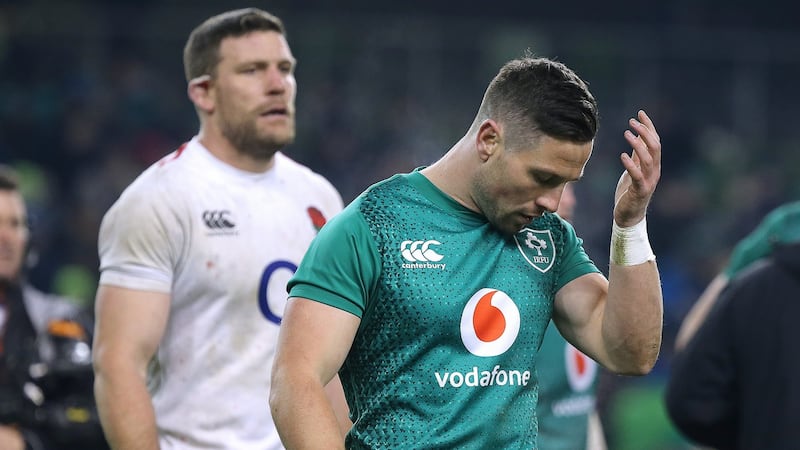Ireland will be measured not by how they lost the game but in the manner in which they address and respond to the defeat. Failure, and all that attends it, disappointment, anger and frustration is part of sport and the challenge for squad is to recalibrate within a week, possibly without two or three first choice players.
Joe Schmidt noted that the Ireland players had come back in a little tired following their exploits in Europe. Given the physical battering they had to absorb from England it makes for a tricky training schedule this week.
Sportspeople are occasionally fond of stating that more is learned in defeat than victory, something the Irish squad will get to road test in earnest this week.
They have returned to ground zero. All their remarkable achievements and milestones over the last year, winning a Grand Slam, a test series in Australia and beating the All Blacks underline the quality within the group but in offering a reminder of what they can achieve when properly attuned, the high water mark within that sequence is the measure by which the squad is judged.
So where did Ireland lose the match?
LOSING THE CONTACT
Ireland lost the vast majority of the collisions, the evidence obvious to the naked eye and starkly illustrated in one of the data measuring tools. During the 80-minutes England made well over 40 dominant tackles to Ireland’s eight, a graphic illustration of which team bossed the collisions.
As a rule of thumb on the day, Ireland’s ruck ball was slow, which meant that they had to send numbers in to rescue the ball and were therefore at a numerical disadvantage as they sought avenues to attack. England could accelerate off the line in defence and were able to win the contact more often than not against stationary or slow moving Irish ball-carriers.
There was very little or no subtlety to what Ireland tried as the carrier easily identifiable and there was no escaping the vice like grip that England exerted in defence, double teaming and chop tackles to the fore, and when Eddie Jones’ side had the ball, they got their power runners over the gain-line, facilitated by superior movement and also a kicking game that kept Ireland guessing and slightly wary.
KICKING GAME
All three matches on the opening weekend demonstrated the value of the kicking game and how important it has become in trying to break down teams. Scotland outhalf Finn Russell demonstrated his repertoire, cross-kicks and grubber kicks, from which tries came.
The range of England's kicking through Ben Youngs, Owen Farrell, Henry Slade and Elliot Daly was infinitely superior to Ireland's giving the visitors both good field position and also a forerunner to scoring tries. The visitors chose to pummel Ireland around the fringes and in midfield encouraging Ireland to increase the line speed in defence and as soon as they did Farrell, Daly and Slade spotted the green space in behind.
Ireland had a chance to kick off first phase with generally only one deep lying English player but in largely ignoring that option, they were often forced into box-kicking from slow, static ruck ball with three of four Englishmen waiting in the backfield and they dealt with the threat very easily. England blocked on the Irish kick/chase without catching the attention of the referee.
HALFBACKS OUT OF SORTS
Playing in the halfbacks for Ireland on Saturday evening would have been a tough remit given the nature of possession offered up but Jonathan Sexton and Conor Murray were both out of sorts, delivering below par performances. Sexton, out for four weeks beforehand, lacked his customary sharpness and authority, at times over playing the ball.

It’s difficult to remember a time when he grassed as many passes. Ireland’s passing in general represented a challenge for the intended receiver, where he often had to check or reach above his head to secure the ball.
Murray is struggling for form a little recently and his overall contribution was several notches below his imperious best. The game might have served as an opportunity to provide John Cooney with game time; three minutes, despite his try scoring cameo, was a wasted chance to measure him in a meaningful game in the test arena. He should have been given 20-minutes at least.
SLOW TO CHANGE
Hindsight is an exact science but there seemed to be a reluctance to make changes when there was some pretty compelling evidence to do so. It would have been interesting to see a change at halfback, even for 10-minutes, albeit acknowledging that Joey Carbery was introduced due to Garry Ringrose's injury.
The replacements brought energy not to the point where they were going to rescue a result but contributions were largely positive. The heading applies equally to the gameplan. Ireland were a little bit prescribed at times and instead of playing what was in front of them in problem solving and trying a different tack, they stuck a little too rigidly to the patterns.
There is always a balance to be struck but patterns are parameters in between which to play not shackles to restrict. Everything needs to be a great deal slicker if Ireland are to get to the edges or run trap plays through the midfield.
NEW BLOOD AND EXPERIMENTATION
Injuries will determine some changes and it will be interesting to see if Schmidt sticks or twists when it comes to playing Robbie Henshaw at fullback. Will Addison will definitely come into the reckoning, so too Rob Kearney, Andrew Conway, Chris Farrell, Quinn Roux, Ultan Dillane, Jack Conan and Rhys Ruddock.
There is no reason to panic. It’s still an excellent playing cadre and well-coached group but sometimes what is in plain sight is the most difficult thing to see. Form and match sharpness are important and perhaps of all the lessons Ireland learned at the Aviva stadium on Saturday, it is one to bear in mind heading for Murrayfield.













